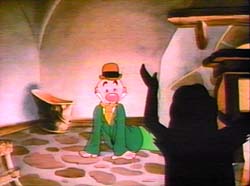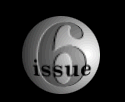|
The fairy tale plot tends to be grimly schematic and deterministic: the reader knows that dire events will follow from Red Riding Hood telling the wolf where her grandmother lives. Avery's "plots" (one must use quote marks) are filled with distancing devices and narrative ruptures that make the universe appear far less predictable. In "The Bear's Tale," the story itself is fractured, as Red Riding Hood inexplicably appears in what's supposed to be an account of "Goldilocks and the Three Bears." (Red saves Goldie from the wolf by reaching over the split-screen line that separates them.) In "Little Red Walking Hood," the action of the story is interrupted, to the loud disgust of the actor-wolf and actor-girl, by what appear to be real-life silhouettes of people clumsily entering the theatre and trying to find a seat to see the cartoon. "Cinderella Meets Fella" has a happier version of this distancing device, as Cinderella disappears, only to turn up as a real-life shadow waving and yelling at "Fella" (who's still onscreen and in the narrative proper) from the audience watching the cartoon. Avery's inclusion of the audience -- even in silhouette form -- in the story undermines the linear narrative, and any potential moral that might be derived from it, by pointing out that these are, after all, only fictional inventions.

In "Cinderella Meets Fella," Princy (Egghead) looks for
Cinderella and finds her in the theater audience.
Avery has never been considered a "personality animator" in the mode of Disney, and never thought of himself as such, though it's hard not to see "personality" in characters like the eternally aroused Wolf, or the stupidly self-absorbed papa Bear in "The Bear's Tale," or for that matter in his sexy, droll Cinderellas and Red Riding Hoods. While Disney is correctly credited with singlehandedly rescuing the animated cartoon from the simple gag orientation of the silent era, many of his much-vaunted "characters" are quite dull, particularly the saccharine fairy tale heroines Cinderella and Snow White. (He got more mileage out of the Wolf in the Three Little Pigs, perhaps because of that film's unavoidable connection to the too-close terrors of the Depression.) Contrast the Disney version with Avery's "Swing Shift Cinderella." Key elements of this familiar tale are blithely dumped; there's no glass slipper here, or tearful reunion with the prince. (There's no prince.) For love interest, Avery recruits Red Riding Hood's horny Wolf. Cinderella's no longer the timid drudge of Disney, Grimm, or Perrault, but a busty pin-up babe who does a sexy song-and-dance act that drives the wolf into a frenzy of lust. The story becomes increasingly unrecognizable, no longer a morality tale about the rewards of being "good" but a campy erotic farce in which the Wolf pursues Cinderella while trying to resist the equally frantic attentions of an aged fairy godmother on the make.
Avery's relentless sexual motifs are a crucial part of his attack on Disney. In "The Bear's Tale," Goldilocks is skipping through the forest with exaggeratedly cloying moves, swinging her hands wildly through the air with a vacuous grin. But typical of Avery, he rescues her from the Disneyesque bathos that her first appearance implies; she confronts the Wolf in Grandma's bed, and he's disgusted with the fact that she's not Red Riding Hood. She then does a surprisingly lascivious stroll in front of him and says provocatively, "What's she got that I haven't got?" Red is no longer the blank identification figure of the written versions, waiting for rescue by the hunter, but a willful, sexually aware gamin who may be as attracted to the wolf as he is to her. "Little Red Walking Hood" is another visually childlike character, at least in height, who shows an adult sexuality; her courtship by the wolf is typical of a kind of comic quasi-bestiality theme that runs through Avery's work.
Avery discussed this idea in an interview with Joe Adamson; it was something he was well aware of in his career because he had censorship problems with it. The title character of "Red Hot Riding Hood" was designed as a pin-up, to boost Army morale, but the Hays Office objected to the wolf's reaction to Red -- "showing body heat, the steam coming out of the collar, and the tongue rolling out" and forced Avery to make cuts. "Sometimes we would just stiffen him out in mid-air; he'd make a take and his whole body would stiffen out like an arrow! And they cut that one out on us." Such imagery was apparently important enough to Avery that, rather than capitulate, he devised a strategy to salvage it. He would insert a number of over-the-top gags he knew would be cut, and the ones he really wanted would be left alone by a then-satisfied censor.5 Like Djuna Barnes, Avery knew that kids -- and soldiers -- "like Red Riding Hood and the wolf in bed!"
page 2 of 4
 
|




